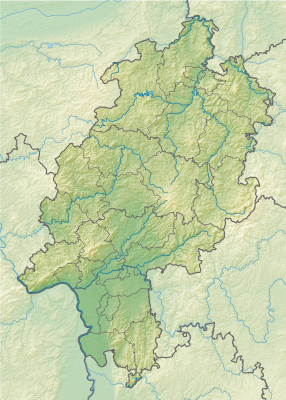Wallenfels Castle
| Wallenfels Castle | ||
|---|---|---|
|
Castle hill from the southwest, on the hilltop rubble cone of the castle |
||
| Creation time : | around 1324/1328 | |
| Castle type : | Hilltop castle | |
| Conservation status: | Remnants of the foundation, neck ditch | |
| Standing position : | Landgraves | |
| Place: | Siegbach -Wallenfels | |
| Geographical location | 50 ° 46 '43.5 " N , 8 ° 26' 41.1" E | |
| Height: | 498 m above sea level NHN | |
|
|
||
Wallenfels Castle are the remains of a hilltop castle on the 498 meter high steep mountain cone above the village of the same name in the municipality of Siegbach in the Lahn-Dill district in Hesse . It was first documented in 1334 as "Waltinfels". It had been uninhabited since around 1480, fell into disrepair and was demolished.
history
It is not known exactly when the castle was built. Landgrave Otto I of Hesse probably had it built between 1324 and 1328 towards the end of the so-called Dernbach feud . The castle was supposed to support the knights of Dernbach ( Burg Alt-Dernbach ) and von Bicken in the fight against the Counts of Nassau and to secure the property of the Lords of Bicken zu Marburg-Wolkersdorf for Hesse. In addition, it was supposed to protect the important trade routes and highways ( Brabanter Straße , Westfalenweg and Herborner Hohe Straße ) that ran through the Schelder Forest at that time and that crossed near the Angelburg on behalf of Hesse.
The small Hessian castle seems to have survived the feuds (Dernbacher Feud) that flared up again in 1327 and 1328 between the Landgraviate of Hesse, the Lords of Dernbach and von Bicken on the one hand and the Counts of Nassau with the support of the Archbishop of Mainz on the other.
After the feud was over, the castle remained in the possession of the Counts of Nassau as a Hessian fief from 1334. However, it had lost its strategic and military importance and function afterwards. In 1344 the castle of Nassau was pledged to the Lords of Bicken . After that, various noble families had their seat there. Count Johann IV. Von Nassau-Dillenburg redeemed the castle in 1468. The Hessian sovereignty ended in 1557 with the comparison of Katzenelnbogen. Then Wallenfels finally became Nassau.
As early as the 16th century, Wallenfels Castle was largely in ruins. In the course of time, it was completely removed, probably deliberately (building material for Tringenstein Castle?). Apart from the wide neck ditch , barely visible remains of the foundations and a mound of rubble from the former inner castle building, nothing is left. Today only field names like “Unter der Brücke” and “Portwiese” are reminiscent of the former castle.
description
Based on the investigations from 1986 to 1988, the simple hilltop castle can be described as follows:
The mountain cone to the east of the village was surrounded by an almost oval (larger semi-axis in east-west direction) circular wall, which was separated from the neighboring mountain by a neck ditch to the east , through which a forest path runs today, and over which the eastern, probably only, access to the castle was established by a bridge. In the northern part the curtain wall ran almost in a straight line. On the west side will keep suspects to the centrally Palas joined. To the northeast, next to the access road, was a well. Remnants of it were still visible in 1987. To the south, leaning against the curtain wall, two buildings have been identified. On the northern slope facing the village under the remains of the curtain wall there is a (presumably modern) rock cellar driven into the mountain .
literature
- Rudolf Knappe: Medieval castles in Hesse - 800 castles Castle ruins and fortifications . 3rd edition, Wartberg Verlag, Gudensberg-Gleichen 2000, ISBN 3-86134-228-6 , p. 423;
- Horst W. Müller: Castle "Wallenfels", the unknown, story of a small castle on the border with the hinterland ; Hinterland history sheets, 88 year, No. 3, October 2009, Biedenkopf
- Georg Wilhelm Sante (Hrsg.): Handbook of the historical sites of Germany . Volume 4: Hessen (= Kröner's pocket edition . Volume 274). Unchanged reprint of the 3rd edition. Kröner, Stuttgart 1993, ISBN 3-520-27403-5 .
Web links
- Wallenfels Castle, Lahn-Dill district. Historical local lexicon for Hesse (as of June 11, 2014). In: Landesgeschichtliches Informationssystem Hessen (LAGIS). Hessian State Office for Historical Cultural Studies (HLGL), accessed on October 4, 2018 .
- Wallenfels Castle on burgenwelt.de
- Literature about Wallenfels Castle in the Hessian Bibliography




